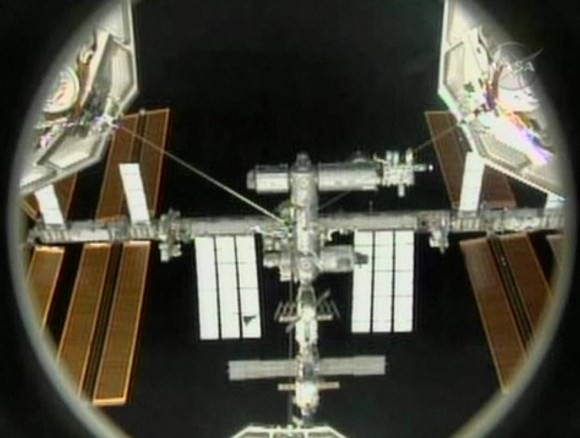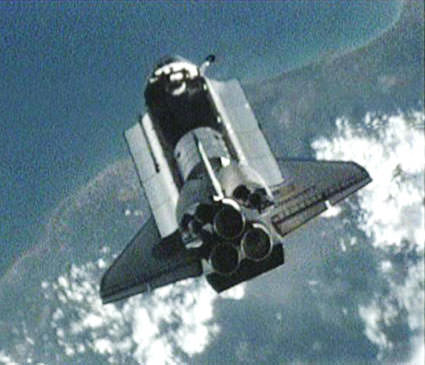Space Shuttle Discovery performed a spectacular “Radar Failed” rendezvous and docking at the International Space Station this morning (April 7) at 3:44 AM as the two massive ships were flying in formation some 225 miles over the Caribbean Sea near Caracas, Venezuela. Discovery’s blast off on April 5 began a two day pursuit of the station.
Hatches between Discovery and the ISS were opened at 5:11 AM EDT this morning, bringing together the seven-person shuttle crew and the six-person space station crew, to begin nine days of joint work and operations. The primary goal of the STS 131 mission is to outfit the station with numerous new science experiments, install a new crew sleeping quarter and to resupply stocks of essential parts and provisions.
[/caption]Discovery’s cargo bay is packed with the 27,000 pound Leonardo Multi Purpose Logistics module built by the Italian Space Agency and a nearly 4,000 pound ammonia cooling tank.
The joint crew of 13 people marks several notable historic firsts in space exploration, including the largest ever gathering of female astronauts and Japanese astronauts in space.
For the first time in history there are four female astronauts simultaneously working together in space. Discovery Mission Specialists Dottie Metcalf-Lindenburger, Stephanie Wilson and Japan Aerospace Exploration Agency (JAXA) astronaut Naoko Yamazaki join ISS Expedition 23 Flight Engineer Tracy Caldwell Dyson who rocketed to orbit just days ago on April 3 and arrived at the ISS on Easter Sunday.

Expedition 23 Flight Engineer Soichi Noguchi and Mission Specialist Yamazaki are the first JAXA Astronauts to fly in space at the same time. A horde of Japanese media and officials were on hand at KSC to witness the launch of Discovery. This space first is a source of great pride in Japan.
The flawless maneuvers linking the two giant ships together were conducted with “no radar” because of the failure of the high speed Ku-Band communications antenna normally used shortly after blast off on April 5.
The STS 131 astronaut crew led by Shuttle Commander Alan Poindexter had to rely on back up navigation systems to precisely track the station and guide Discovery to a position in front of the ISS and then gently dock at the Harmony module (Node 2). The crew are trained to rendezvous and dock without radar.
Station Commander Oleg Kotev and NASA astronaut TJ Creamer took high resolution images of Discovery’s heat shield during the 8 minute back flip maneuver to document the condition and integrity of the many thousands of critical thermal protection tiles fastened to the belly, wing leading edges and nose cap of Discovery.
The pair snapped hundreds of photos using 400 mm and 800 mm cameras through portholes from their location inside the Russian Zvezda Service Module. These photos will be thoroughly scrutinized by imagery experts back at Mission Control in Houston to look for any signs of damage to the heat shield before NASA commits Discovery to the scorching heat of reentry and a return landing back on Earth.
Earlier STS 131 related articles by Ken Kremer:
Antenna Glitch hinders Data Flow from Inspection of Discovery
Discovery Dazzles with Two Dawns in One Day
Discovery Unveiled on Easter Sunday to the Heavens Above
Countdown Clock Ticking for Discovery Blast off on April 5
Soyuz Blasts off with Russian American Crew for Easter ISS arrival


It is so “2001 : A Space Odyssey” I.e The Orion docking with the spinning space station.
Really expected to here Strauss’s “The Blue Danube “
they should close the payload bay doors when they do this. The doors are obscuring the view of the leading edge of the wing where the breach occurred causing the loss of Columbia
Closing the doors creates problems with heat, and the belly flip lets them see the leading edge anyway.